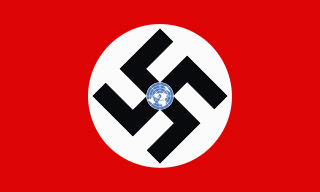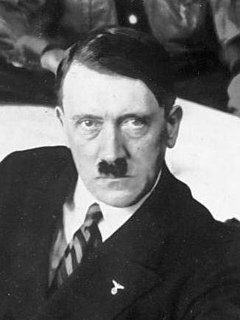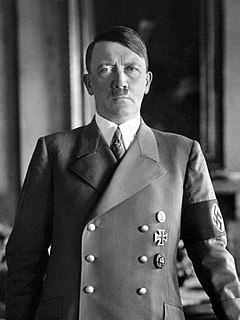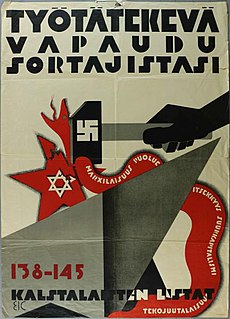
Hermann Wilhelm Göring was a German politician, military leader and convicted war criminal. He was one of the most powerful figures in the Nazi Party, which ruled Germany from 1933 to 1945.

Paul Joseph Goebbels was a German Nazi politician who was the Gauleiter of Berlin, chief propagandist for the Nazi Party, and then Reich Minister of Propaganda from 1933 to 1945. He was one of Adolf Hitler's closest and most devoted acolytes, known for his skills in public speaking and his deeply virulent antisemitism, which was evident in his publicly voiced views. He advocated progressively harsher discrimination, including the extermination of the Jews in the Holocaust.

The Wannsee Conference was a meeting of senior government officials of Nazi Germany and Schutzstaffel (SS) leaders, held in the Berlin suburb of Wannsee on 20 January 1942. The purpose of the conference, called by the director of the Reich Security Main Office SS-Obergruppenführer Reinhard Heydrich, was to ensure the co-operation of administrative leaders of various government departments in the implementation of the Final Solution to the Jewish question, whereby most of the Jews of German-occupied Europe would be deported to occupied Poland and murdered. Conference participants included representatives from several government ministries, including state secretaries from the Foreign Office, the justice, interior, and state ministries, and representatives from the SS. In the course of the meeting, Heydrich outlined how European Jews would be rounded up and sent to extermination camps in the General Government, where they would be killed.
The Sturmabteilung was the Nazi Party's original paramilitary wing. It played a significant role in Adolf Hitler's rise to power in the 1920s and 1930s. Its primary purposes were providing protection for Nazi rallies and assemblies, disrupting the meetings of opposing parties, fighting against the paramilitary units of the opposing parties, especially the Roter Frontkämpferbund of the Communist Party of Germany (KPD) and the Reichsbanner Schwarz-Rot-Gold of the Social Democratic Party of Germany (SPD), and intimidating Romani, trade unionists, and especially Jews.

The Munich Agreement was an agreement concluded at Munich on 30 September 1938, by Germany, the United Kingdom, France, and Italy. It provided "cession to Germany of the Sudeten German territory" of Czechoslovakia, despite the existence of a 1924 alliance agreement and 1925 military pact between France and the Czechoslovak Republic, for which it is also known as the Munich Betrayal. Most of Europe celebrated the Munich agreement, which was presented as a way to prevent a major war on the continent. The four powers agreed to the German annexation of the Czechoslovak borderland areas named the Sudetenland, where more than three million people, mainly ethnic Germans, lived. Adolf Hitler announced that it was his last territorial claim in Northern Europe.

The Enabling Act of 1933, officially titled Gesetz zur Behebung der Not von Volk und Reich, was a law that gave the German Cabinet—most importantly, the Chancellor—the powers to make and enforce laws without the involvement of the Reichstag or Weimar President Paul von Hindenburg. Critically, the Enabling Act allowed the Chancellor to bypass the system of checks and balances in the government and the laws created under it could explicitly violate individual rights prescribed in the Weimar Constitution.

The American Nazi Party (ANP) is an American independent neo-Nazi political party founded by George Lincoln Rockwell and headquartered in Arlington, Virginia. Rockwell founded the organization as the World Union of Free Enterprise National Socialists (WUFENS), but renamed it the American Nazi Party in 1960. Since the late 1960s, a number of small groups have used the name "American Nazi Party" with most being independent of each other and disbanding before the 21st century. The party is based largely upon the ideals and policies of Adolf Hitler's Nazi Party in Germany during the Nazi era, and embraced its uniforms and iconography.

Odilo Lothar Ludwig Globocnik was an Austrian Nazi and a perpetrator of the Holocaust. He was an official of the Nazi Party and later a high-ranking leader of the SS. Globocnik had a leading role in Operation Reinhard, the organized murder of around one and a half million Jews, of mostly Polish origin, during the Holocaust in the Majdanek, Treblinka, Sobibor and Belzec extermination camps. Historian Michael Allen described him as "the vilest individual in the vilest organization ever known". Globocnik took his own life shortly after his capture and detention by British soldiers.
Staffelführer was one of the first paramilitary ranks used by the German Schutzstaffel (SS) in the early years of that group's existence. The later SS rank of Staffelführer traces its origins to the First World War, where the title was used by commanding officers of the Deutsches Heer's Luftstreitkräfte aircraft squadrons initially named as Feldflieger Abteilung as observation-only units in 1914, and during 1916, became known as Staffeln.

The National Renaissance Party (NRP) was an American neo-fascist group founded in 1949 by James Madole. It was frequently in the headlines during the 1960s and 1970s for its involvement in violent protests and riots in New York City. After Madole's death in 1979 the party faded and had completely disappeared by 1981.

Federal elections were held in Germany on 5 March 1933, after the Nazi seizure of power on 30 January 1933 and just six days after the Reichstag fire. Nazi stormtroopers had unleashed a widespread campaign of violence against the Communist Party (KPD), left-wingers, trade unionists, the Social Democratic Party of Germany, and the Centre Party. They were the last multi-party all-German elections until 1990.

Adolf Hitler was an Austrian-born German politician who was the dictator of Germany from 1933 until his death in 1945. He rose to power as the leader of the Nazi Party, becoming the chancellor in 1933 and then assuming the title of Führer und Reichskanzler in 1934. During his dictatorship, he initiated World War II in Europe by invading Poland on 1 September 1939. He was closely involved in military operations throughout the war and was central to the perpetration of the Holocaust, the genocide of about six million Jews and millions of other victims.

Nationalsocialistiska Arbetarepartiet was a Swedish political party that initially espoused Nazism before adopting a more indigenous form of fascism. It was also widely infamous under the name Svensk socialistisk samling, which was generally among the public called "Lindholmarna".

Adolf Hitler's rise to power began in the newly established Weimar Republic in September 1919 when Hitler joined a political party known as the Deutsche Arbeiterpartei – DAP. Hitler rose to a place of prominence in the early years of the party. Being one of its best speakers, he was made the party leader after he threatened to otherwise leave.

Montoire-sur-le-Loir, commonly known as Montoire, is a commune near Vendôme, in the Loir-et-Cher department in Centre-Val de Loire, France.
Bela Ewald Althans is a German former neo-Nazi. Once the leading organiser in Germany's neo-Nazi underground, Althans left the movement following his imprisonment in the 1990s, and is no longer involved in politics.
Events in the year 1937 in Germany.

The Nazi salute, also known as the Hitler salute, or the Sieg Heil salute, is a gesture that was used as a greeting in Nazi Germany. The salute is performed by extending the right arm from the neck into the air with a straightened hand. Usually, the person offering the salute would say "Heil Hitler!", "Heil, mein Führer!", or "Sieg Heil!". It was adopted in the 1930s by the Nazi Party to signal obedience to the party's leader, Adolf Hitler, and to glorify the German nation. The salute was mandatory for civilians but mostly optional for military personnel, who retained the traditional military salute until the failed assassination attempt on Hitler on 20 July 1944.
Asgardsrei festival is an annual National Socialist black metal (NSBM) festival in Kyiv, Ukraine.

The Finnish People's Organisation was a bilingual Nazi party founded by Jaeger Captain Arvi Kalsta. Supporters of the movement were also called Kalstaites after the leader. The inaugural meeting of the organization was held in March 1933 and was attended by about 500 members. SKJ published the magazines Herää Suomi, Hakkorset and Hakaristi. In addition to its own magazines, the organization had its own publishing house Vasara. The organization wore a brown uniform like the Sturmabteilung of the German Nazi Party, and used the greeting "Finland Awake!"














